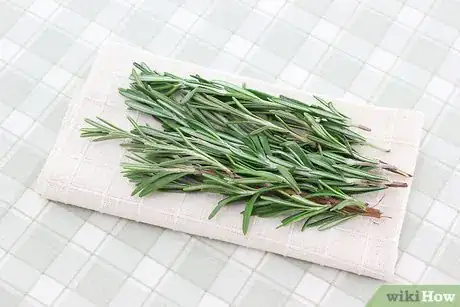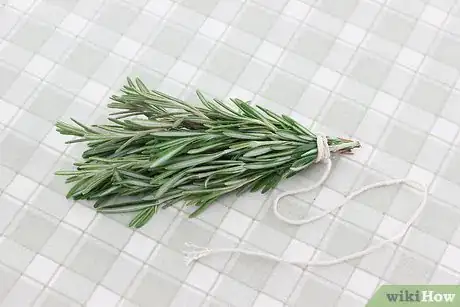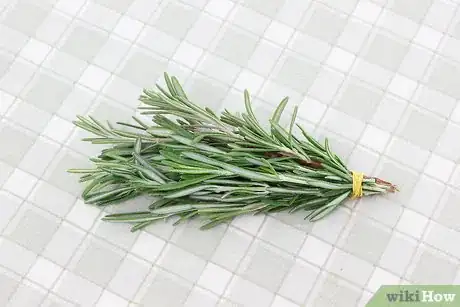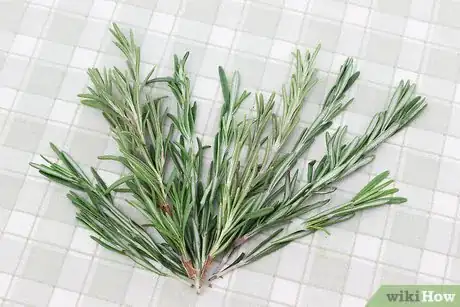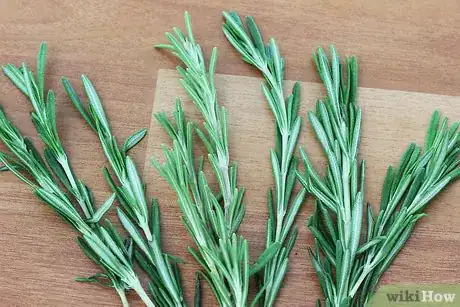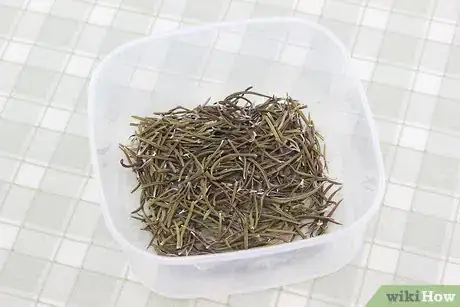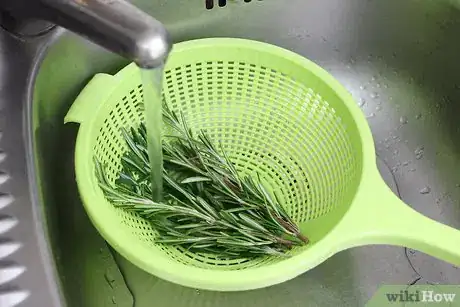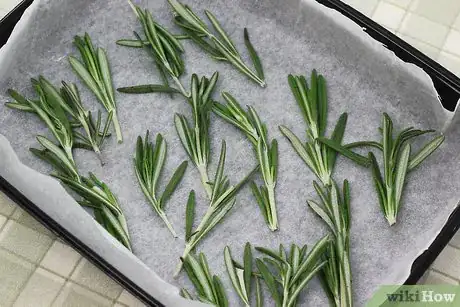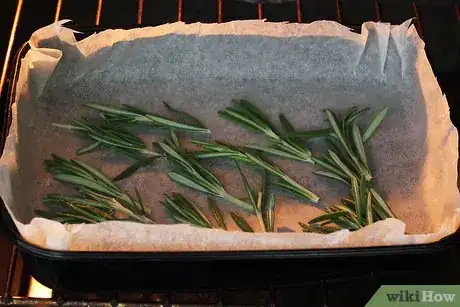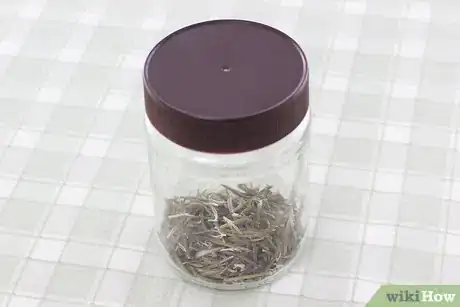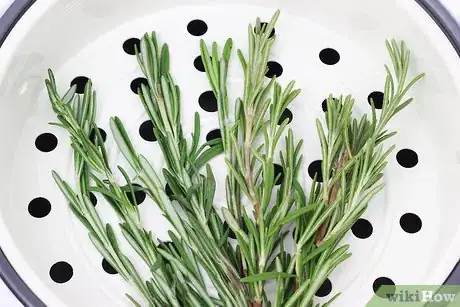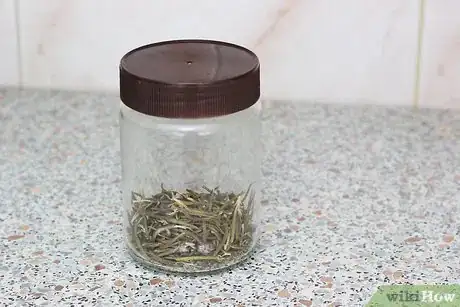wikiHow is a “wiki,” similar to Wikipedia, which means that many of our articles are co-written by multiple authors. To create this article, 16 people, some anonymous, worked to edit and improve it over time.
There are 11 references cited in this article, which can be found at the bottom of the page.
wikiHow marks an article as reader-approved once it receives enough positive feedback. This article received 12 testimonials and 100% of readers who voted found it helpful, earning it our reader-approved status.
This article has been viewed 323,988 times.
Learn more...
Aromatic and flavorful, rosemary is one of the sturdiest and most popular herbs. Unlike many other herbs, rosemary loses little of its flavor when dried, which makes it a great choice for drying and storing at home. Drying rosemary is very easy to do, and will ensure that you have plenty of this aromatic herb at hand for use in your favorite dishes. Dried sprigs of rosemary are also a lovely, aromatic decoration.
Steps
Using the Hanging Method
-
1Use scissors to snip sprigs of rosemary off the plant. The best time to harvest your rosemary is in the morning, after the sun has dried away any nighttime dew.
- Your rosemary plant will bush out with vigorous growth from the places where you pinched or snipped it.
- Try to snip straight sprigs, all about the same length, for easier bundling.
-
2Tie the sprigs into bundles, wrapping twine around the bases of the sprigs. Leave a loop on the twine bundle to make hanging your rosemary sprigs easier.[1]
- Alternatively, you can use rubber bands to secure your rosemary bundles.
- You can combine up to eight sprigs of rosemary per bundle.
Advertisement -
3Hang the rosemary sprigs in a cool, dry and well-ventilated place to dry. Although you can dry your rosemary outdoors, the National Center for Home Food Preservation recommends drying rosemary indoors for the best color and flavor.
- Your porch, attic, or storage cupboard are all good drying options. You can try hanging the rosemary bundles from a clothes hanger, if this is more convenient.
- Some people also recommend covering your rosemary with brown paper bags as it dries. This prevents any dust from settling on the rosemary as it dries and also stops any sunlight from bleaching out the color. Just be sure to tear holes in the paper bags to keep the rosemary well ventilated.
-
4Turn the drying rosemary sprigs every day or two to ensure even drying. You'll know the rosemary is dry when all traces of pliability are gone from both stems and leaves. This should take approximately two weeks.[2]
- You can also spread your rosemary sprigs or bundles on a flat or slanted window screen, elevated on cinder blocks or wooden blocks, for the best air circulation as they dry.
- You won't be able to hang-dry rosemary sprigs in a humid environment, so you may need to dry your rosemary in the oven or in a food dehydrator.
-
5Store the dried rosemary. Once the rosemary has completely dried, place it on a sheet of waxed paper and separate the tough, woody stems from the leaves. Store in an air-tight container in your kitchen cupboard. Use your dried rosemary in recipes such as lamb roasts and stews, garlic and herb bread, and rosemary-infused oil and butter.
Using the Oven
-
1Prepare the rosemary. Rinse the rosemary well in cold water to remove any remaining dirt or debris. Pat dry with paper towel or use a salad spinner to remove moisture. Pick off any withered leaves or woody stems.
-
2Spread the rosemary on a baking sheet. Place the rosemary - cut into 1⁄4 inch (0.6 cm) sprigs - onto a baking sheet lined with parchment paper. Do not overcrowd.
-
3Place in the oven. Place the baking sheet onto the top shelf of an oven preheated to the lowest temperature.[3] Leave to bake for 2 - 4 hours, until the stems of the rosemary are brittle.
-
4Transfer the rosemary to a storage jar. Once out of the oven, leave the rosemary to cool completely. Gather up the edges of the parchment paper to form a funnel and slide the dried rosemary into a clean glass jar. Seal the jar tightly and store in a dry, dark place, such as your kitchen cupboard.
Using a Food Dehydrator
-
1Prepare the rosemary.[4] Rinse the rosemary and shake or blot it dry, or use a salad spinner to remove excess moisture.
-
2Spread the rosemary onto dehydrator trays. Run the dehydrator at a low heat setting (between 95 and 105 degrees Fahrenheit, or 35 and 40.5 degrees Celsius) until the rosemary stems break when bent.
- Herbs that are more delicate crumble when dry, but rosemary leaves are more likely to break, much like the stems.
- The exact amount of time it takes to dry rosemary using this method will vary, but on average, it takes about 6 to 8 hours at 95 degrees Fahrenheit (35 degrees Celsius).[5]
-
3Store in a clean, glass jar. Transfer the dried rosemary to a clean, glass jar and seal tightly. Store in a dry, dark cupboard.
Community Q&A
-
QuestionCan I fine grind rosemary to pour like salt?
 Community AnswerYes, though you may want a grinder or stone grinder. It would take a lot of time and effort, but it's possible.
Community AnswerYes, though you may want a grinder or stone grinder. It would take a lot of time and effort, but it's possible. -
QuestionHow long will the dried rosemary last?
 CahnnyCommunity AnswerI dry rosemary every summer. I store mine in small dark glass jars and keep them in a drawer in my kitchen far away from the stove or any heat source. I keep mine for a year, and it stays perfectly fresh.
CahnnyCommunity AnswerI dry rosemary every summer. I store mine in small dark glass jars and keep them in a drawer in my kitchen far away from the stove or any heat source. I keep mine for a year, and it stays perfectly fresh. -
QuestionCan you use rosemary that dried on the branches after being in a vase of water?
 Community AnswerProvided it is clean and dust-free, this is perfectly fine to use. If you're not sure whether or not it's clean, give it a quick tinkle under a gently dripping tap, then leave to dry again in sunlight, such as on a dish rack in the windowsill.
Community AnswerProvided it is clean and dust-free, this is perfectly fine to use. If you're not sure whether or not it's clean, give it a quick tinkle under a gently dripping tap, then leave to dry again in sunlight, such as on a dish rack in the windowsill.
Things You'll Need
- Scissors
- Twine or string
- Brown paper bags (optional)
- Food dehydrator
- Baking sheets
- Parchment paper
- Clean, air-tight containers or glass jars
References
- ↑ http://www.ourherbgarden.com/rosemary/drying-rosemary.html
- ↑ https://www.gettystewart.com/how-to-cut-and-dry-rosemary/
- ↑ https://www.thekitchn.com/4-ways-to-preserve-fresh-rosemary-221277
- ↑ https://www.epicurious.com/expert-advice/how-to-dry-rosemary-step-by-step-article
- ↑ https://momwithaprep.com/how-to-dehydrate-rosemary/
- ↑ https://www.thekitchn.com/4-ways-to-preserve-fresh-rosemary-221277
- ↑ https://www.medicalnewstoday.com/articles/266370.php
- https://www.youtube.com/watch?v=860I7IBu_cc
- https://momwithaprep.com/how-to-dehydrate-rosemary/
About This Article
To dry rosemary, start by snipping sprigs off the plant that are approximately the same length so that you can bundle them together efficiently. Next, separate the sprigs in groups of 8 to create small bundles. Then, wrap twine or rubber bands around the bases of the sprigs to hold the bundles together. Finally, hang the sprigs indoors in a cool, dry, and well-ventilated area for about 2 weeks, turning the sprigs every 1-2 days to ensure even drying. For tips on using your oven for faster drying, read on!


